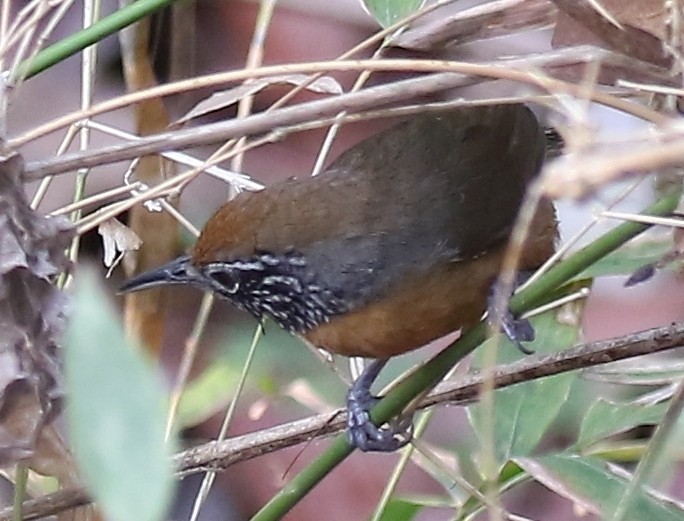Rufous-breasted Wren
A species of Pheugopedius Wrens Scientific name : Pheugopedius rutilus Genus : Pheugopedius Wrens
Rufous-breasted Wren, A species of Pheugopedius Wrens
Botanical name: Pheugopedius rutilus
Genus: Pheugopedius Wrens
Content
Description General Info
 Photo By lucaboscain , used under CC-BY-NC-4.0 /Cropped and compressed from original
Photo By lucaboscain , used under CC-BY-NC-4.0 /Cropped and compressed from original Description
The rufous-breasted wren (Pheugopedius rutilus) is a small songbird of the wren family (Troglodytidae). It was formerly placed in the genus Thryothorus which in the old, broad sense was a motley assemblage of similar-looking wrens. It is found in the tropical New World from Costa Rica and Panama east to Colombia, Venezuela, Trinidad and Tobago. It barely reaches into Amazonia in Colombia, being otherwise limited to the northwest part of the northern Andes and neighboring mountain ranges. Adult rufous-breasted wrens are 14 cm (5.5 in) long and weigh 16 g (0.56 oz). They have grey-brown upperparts and black bars on the tail. The throat and face sides are speckled black and white. The breast is rufous while the belly is brownish white and the flanks brown. They have a faint line over the eye and a short thin bill. The face pattern and rufous breast are the best distinctions from the similarly-sized house wren. The rufous-breasted wren's song is a musical whistle of six to ten notes, too-see-HEEear-too-see, too-see-HEEear-too-see . The contact call is a sharp cheep, given as these skulking birds forage in vegetation for insects and centipedes. The subspecies Pheugopedius rutilus tobagensis, found on Tobago, is larger and has darker underparts than the nominate subspecies P. r. rutilus of Trinidad and northern Venezuela. There are five other mainland forms to the west of these. The breeding habitat is forest undergrowth and thickets, also utilizing fragmented forest and secondary growth. The nest is a large sphere of leaves and grass with a side entrance, concealed in tangled vegetation. The female incubates the clutch of two to four brown-blotched white eggs, and the naked young take 16 days to fledge. 
Size
14 cm
Nest Placement
Shrub
Feeding Habits
Rufous-breasted Wren primarily consumes insects like beetles, bugs, flies, and hymenopterans, with a sporadic intake of small seeds. Utilizing active foraging techniques, rufous-breasted Wren showcases distinctive dietary preferences amidst dense vegetation. Unique adaptations include specialized foraging methods aligning with its diverse insectivorous diet.
Habitat
Rufous-breasted Wren typically inhabits the understorey of rainforests and cloudforests, thriving in areas such as thickets, second growth, and edges of forests rather than the interior of dense forests. These birds are found across a broad elevation range from sea level up to 1900 meters, showing a preference for regions where the vegetation provides adequate cover and complexity.
Dite type
Insectivorous
General Info
Feeding Habits
Bird food type
Scientific Classification
Phylum
Chordates Class
Birds Order
Perching birds Family
Wrens Genus
Pheugopedius Wrens Species
Rufous-breasted Wren